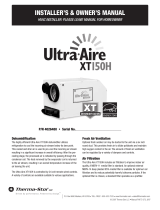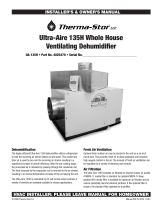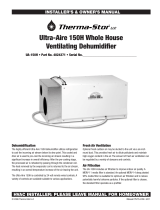
START UP AND SEQUENCE OF OPERATION
SINGLE ZONE WHOLE HOUSE OR STAND ALONE USING
THE DEHUMIDIFIER CONTROL
SINGLE ZONE WHOLE HOUSE OR STAND ALONE USING
MODEL 76 EXTERNAL CONTROL
CRAWL SPACE OR SEALED ATTIC (REMOTE) CONTROL
USING MODEL 76
TWO ZONE – PRIMARY AND SECONDARY
1. Press the ON/OFF button to turn the dehumidifier control ON. The
display will show the current setting, and the dehumidifier blower
and HVAC blower (if wired to the HVAC system) will turn on to
start sampling the air.
The setting will be replaced by the measured humidity and “AIR
SAMPLING”willshowonthedisplay.
2. Use the UP or DOWN button to adjust the humidity setting as
desired. The recommended initial setting is 59%.
3. After three (3) minutes of sampling, the measured humidity will be
compared to the setting:
a. If the humidity is above the setting, the dehumidifier
compressorturnsonand“AIRSAMPLING”willbereplaced
by“DEHUMIDIFYING”.Thecompressorremainsonuntilthe
measured humidity falls 3% RH below the setting.
b. If the measured humidity is below the setting, the blowers turn
off and the display returns to showing the RH setting.
4. The dehumidifier will sample again every 60 minutes, or at any
time if the humidity setting is lowered.
1. Press the ON/OFF button to turn the dehumidifier control ON.
“EXTERNAL”willshowonthedisplaytoindicatethatanexternal
control is wired to the dehumidifier.
2. At the Model 76, press the ON button; the Model 76 will display
the measured RH.
3. Use the UP or DOWN button on the Model 76 to adjust the
humidity setting as desired. The recommended initial setting is
59%.
4. If the RH measured by the Model 76 rises above the setting,
the dehumidifier will turn on as will the HVAC blower (if wired
totheHVACsystem).“DEHUMIDIFYING”willappearonthe
dehumidifier control display to show that the Model 76 is calling
for dehumidification. The dehumidifier and HVAC blower (if on)
will turn off when the RH measured by the Model 76 drops 3% RH
below the setting.
1. Press the ON/OFF button to turn the dehumidifier control ON.
“REMOTE”willshowonthedisplaytoindicatethataremote
control is wired to the dehumidifier.
2. At the Model 76, press the ON button; the Model 76 will display
the RH measured at the dehumidifier, and the dehumidifier blower
will turn on to start sampling the air.
3. Use the UP or DOWN button on the Model 76 to adjust the dryness
level as desired. The dryness levels are from 1 to 7, with 1 being
least dry and 7 being most dry; the recommended initial setting is
3.
4. After three (3) minutes of sampling, the measured humidity will be
compared to the setting:
a. If the humidity is above the setting, the dehumidifier compressor
turnsonand“ON”flashesontheModel76display.
b. If the measured humidity is below the setting, the dehumidifier
blower turns off.
5. The dehumidifier will sample again every 60 minutes, or at any
time if the dryness level is increased.
1. Press the ON/OFF button to turn the dehumidifier control ON.
Dehumidification of the Primary Zone follows the same sequence
as described to the left for Single Zone, with or without a Model
76 external control installed in the Primary Zone. The dehumidifier
controldisplaywillshow“PRIMARYZONE”inadditionto
that described to the left when sampling or dehumidifying the
Primary Zone. The zone dampers are energized when sampling or
dehumidifying the Primary Zone.
2. The Secondary Zone uses the humidity setting on the dehumidifier
control. During Secondary Zone sampling or dehumidification, the
zone dampers are de-energized and the HVAC blower (if on) stops.
“SECONDARYZONE”willshowonthedehumidifiercontroldisplay
when the Secondary Zone is either sampling or dehumidifying. If
the Primary Zone had just finished a dehumidification demand, the
compressor will continue to run during Secondary Zone sampling to
prevent short cycling of the compressor.
The Secondary Zone is sampled immediately after the Primary Zone
has finished sampling, or if there is a call for dehumidification from
the Primary Zone, immediately after the call has been satisfied.
When a Model 76 external control is installed, the Secondary
Zone will be sampled once per hour if there has not been a call for
dehumidification from the Primary Zone. Secondary Zone sampling
will also occur whenever the setting on the dehumidifier control is
lowered.
18






















